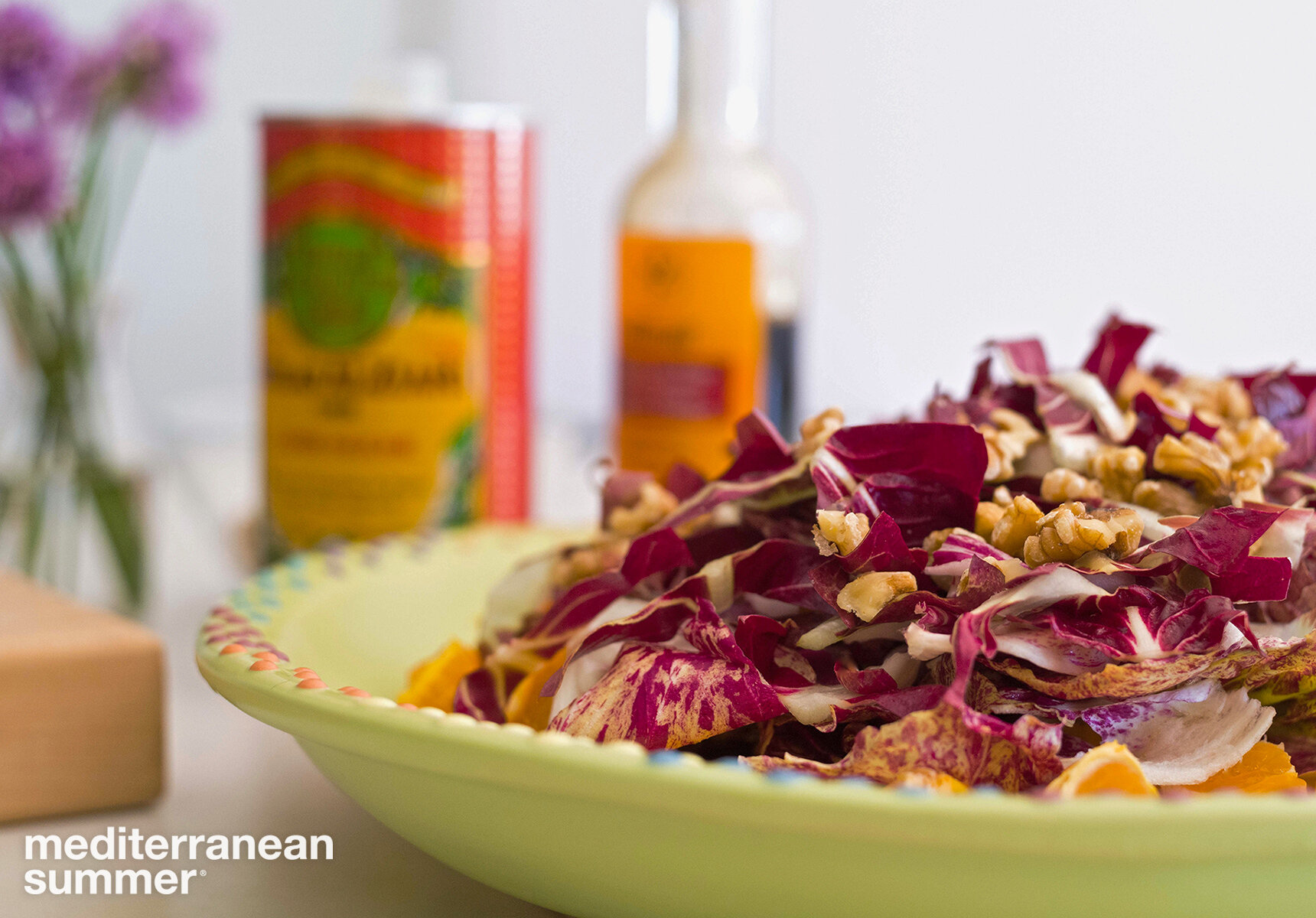Ingredient. Ingredient. Ingredient.
Ingredient-driven cooking is at the core of simplicity. It creates the opportunity in the moment to make decisions about what method is best, how much cooking is necessary (if any), or what other ingredients can or should be used.
A variety of citrus, Radicchio Trevisano, and chicory drizzled with a nice extra virgin olive oil, a splash of aged sherry vinegar, and a scattering of toasted walnuts makes for a fine winter salad. (Photo by Paul Moore)
When I was a line cook with lots of ambition to become a chef, I conditioned myself to believe I needed to constantly create and innovate in order to top the others and be noticed. Living and working in Italy quickly stripped that away. In its place many Italian chefs and home cooks thrust upon me when you start with quality ingredients— materie prime— there isn’t much you have to do to make something delicious.
Ingredient-driven cooking is at the core of simplicity. It creates the opportunity in the moment to make decisions about what method is best, how much cooking is necessary (if any), or what other ingredients can or should be used. Recipes are great resources for direction once ingredient choices are being considered or made.
Having written hundreds of recipes for the page, stage, and screen I am in no way discouraging using them. My concerns are when solely using recipes from the onset, the ingredient list will give what to buy but that doesn’t mean what’s in the store is great or an item might not be available. Therefore it’s important to be flexible when food shopping because there may be an alternative in the next section of the refrigerator, display case, or shelf that can end up better than the original plan.
Read also: Ravenous Food Shopping
Like visiting the spectacular wine making regions of the world, ingredient-driven cooking can inspire destination tasting opportunities: Iberico ham and the giant red Huelva shrimp in Spain, Moroccan Argan oil, melons from Provence in the south of France, black truffles in Perigord or white truffles in Alba, basil from Pra in Liguria, pistachios from Bronte in Sicily, the white eggplant and tiny fava beans of Santorini Island… the list of places and their delicious offerings is almost endless throughout the Mediterranean region!
My first chef’s job was on board a beautiful sailing yacht based in Antibes, France. The Italian owners planned the summer season itinerary to include many ports of call because there were specific foods of those places they wanted to taste— pesto in Liguria, the spiny lobsters from the northeastern corner of Sardinia, and tartufi di mare clams found along the Amalfi Coast.
One of the wonderful tenets of Italian cooking is the almost fanatical adherence to less-is-more. The owner’s wife steered me to make sure I didn’t put too much of something or add too many other flavors that could eradicate the purity and immediacy of the main ingredient.
You can read the full story on board the yacht in my culinary travel memoir, Mediterranean Summer.
It took a while but it finally dawned on me when it comes to the colors, textures, smells, and flavors of raw foods, Mother Nature has already done most of the cooking for us. I decided my role in the kitchen was more of a messenger if I were to keep to the mantra of simplicity. Similarly, a lot of winemakers will tell you their job begins in the vineyards.
“I wanted visitors to be in the vineyard and have a connection to the earth and the fruit. Winemaking begins and ends with it.”
— DAVID DUNCAN, CEO SILVER OAK CELLARS
I wrote copious notes during my sojourn in France and Italy. Occasionally I would grab a quote or section from articles in the International Herald Tribune newspaper I found relevant and taped them into the pages. Here’s one from when I was in Provence, France by a renown songwriter and musician—
“My philosophy is that you can reduce it all down to one note if it’s played with the right feeling and sincerity. The better musician you are, the less notes you play.”
— ERIC CLAPTON, MUSICIAN
Consider the same for food: The better cook you are, the fewer ingredients you use.
Or how about this one from an established American fashion designer—
“Fabric is the absolute dictator. I start with it in my hands. I don’t even know what I want to draw until I know what I am working with.”
— BILL BLASS, FASHION DESIGNER
If Mr. Blass was a chef perhaps he might say, “Ingredients are the absolute dictator. I don’t know what I want to cook until I know what I am starting with.”
And this line in a letter from a master Impressionist painter to a friend about a museum exhibition of his work—
“An artist can’t be great unless he (she) understands the landscape.”
— PIERRE AUGUSTE RENOIR, PAINTER
Without getting too deep into this, the point I am making is to loosen up and embrace a sensory response to the ingredients you choose and give reverence to where they come from. Beyond ingredients, how you feel, the mood you’re in, the weather, a wine you have, or a craving for something spicy or crispy can influence the choices you make. It’s a lot better to live to eat rather than merely eating to live. Just ask someone from Portugal, Morocco, Spain, France, Italy, Greece, or Turkey about this.
I wish for us to focus a part of our day toward the desire for an ingredient and more importantly, the satisfaction of its flavor, or make the time to explore and get inspired by what’s available where we buy food.

